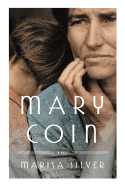
For many Americans, Dorothea Lange's Depression-era photograph of a young mother, brow furrowed, fingers tentatively touching her downturned mouth, summarizes the despair of the Dust Bowl. In Mary Coin, Marisa Silver (The God of War) brings the "Migrant Mother" to life, weaving Mary's story together with that of Vera Dare, a fictionalized counterpart to Lange, and Walker Dodge, the modern-day heir to a California orchard.
Silver's multi-generational novel begins in 2011, as Walker, a college historian, must close down his family's 100-year-old northern Californian ranch. Although Walker lives for research, he knows little of his own family's past. When it comes, the transition to 1920s Oklahoma doesn't jar the reader. There, we meet 16-year-old Mary, barely surviving with her widowed mother and little brothers.
By the time photographer Vera Dare enters the story years later, Mary and her husband are migrant workers, with their four babies in California. (Vera's journey through polio, her work in her San Francisco studio and her marriage to an artist closely mirror Lange's own life.) The reader begins to sense the pending intersection of the women's lives, and the way their stories fit in with Walker's--with the evolution of photography providing a thematic link across the decades--is so well constructed that you can appreciate each narrative thread on its own.
Anyone who meets Marisa Silver's Mary Coin will view Dust Bowl pictures with a new empathy for the subject and the photographer. --Cheryl Krocker McKeon, bookseller, Book Passage, San Francisco

